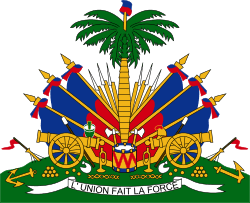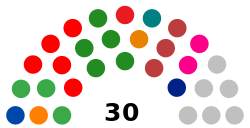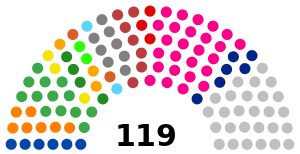Parliament of Haiti
| Parliament of Haiti Parlement Haitien | |
|---|---|
 | |
| Type | |
| Type | |
| Houses |
Senate Chamber of Deputies |
| Leadership | |
President of the Senate | |
President of the Chamber of Deputies | |
| Structure | |
| Seats | |
 | |
Political groups |
Fanmi Lavalas: 1 seat OPL: 1 seat VERITE: 3 seats ALTERNATIVE: 5 seats INITE: 5 seats PITIT DESSALIN: 1 seat LIDE: 1 seat PONT: 1 seat KID: 3 seats PHTK: 2 seats AAA: 1 seat Vacant: 6 seats |
 | |
Political groups |
Fanmi Lavalas: 6 seats OPL: 7 seats VERITE: 13 seats LAPEH: 3 seats INITE: 4 seats FUSION: 3 seats RENMEN: 2 seats CONSORTIUM: 2 seats MOSANO: 2 seats Parties with one seat: 8 KID: 7 seats BOUCLIER: 3 seats PHTK: 26 seats AAA: 6 seats Vacant: 27 seats |
| Meeting place | |
| Palais Législatif, Port-au-Prince | |
| Website | |
|
www | |
 |
| This article is part of a series on the politics and government of Haiti |
| Constitution |
|
Legislature |
|
Judiciary |
|
| Foreign relations |
The parliament of Haiti (French: Parlement Haïtien) is the legislature of the Republic of Haiti. It sits at the Haitian capital, Port-au-Prince.[A103] The Parliament is bicameral, the upper house being the Senate and the lower house being the Chamber of Deputies.[A88]
Houses
Senate
The Senate consists of thirty seats, with three members from each of the ten administrative departments. Prior to the creation of the Nippes Department in 2003, there were twenty-seven seats. Senators are elected by popular vote to six-year terms, with one-third elected every two years. After the elections of 2000, twenty-six of the then twenty-seven seats were held by Jean-Bertrand Aristide's Fanmi Lavalas party. The Senate was not in session following the overthrow of Aristide's government in February 2004. An interim government was put in place following the rebellion, and the remaining Senators were not recognised during that time. The Senate was re-established and elections were held on 21 April 2006. In the Senate elections of 2009 LESPWA won five seats, and five parties won one seat each (OPL, AAA, FUSION, KONBA, UCADDE), as well as an independent.
Chamber of Deputies
The Chamber of Deputies has ninety-nine members (previously eighty-three) who are elected by popular vote to four-year terms. Candidates from Aristide's Fanmi Lavalas party took seventy-three of the then eighty-three seats in the 2000 elections. Following the coup d'état and the overthrow of the government in February 2004, the Chamber of Deputies remained empty. It was re-established along with the Senate, and elections were held on 21 April 2006. The next Chamber elections are scheduled for 2010.
National Assembly
The National Assembly (French: Assemblée Nationale) is a joint session of Parliament. The National Assembly is convened for specific purposes laid out in the Constitution.[A98]
Meetings of the National Assembly are presided over by the President of the Senate, with the President of the Chamber of Deputies assisting. The Secretaries of the Senate and the Chamber of Deputies also serve as Secretaries of the National Assembly.[A99] The National Assembly building was destroyed during the earthquake on 12 January 2010.
Palais Législatif
The Palais Législatif (Legislative Palace)[1][2] was among the many structures which were virtually destroyed by the earthquake on January 12, 2010. Parliament resumed sitting shortly after the earthquake in a temporary classroom.[3]
On 22 November 2011 the government opened new temporary facilities for the Parliament, built with the help of the USAID program.[4]
On 27 December 2012 the first stone of the new Legislative Palace was laid. The main building, horizontal, of 4 levels, will include 3 large sitting rooms for the 2 Chambers and the National Assembly, the Library of Parliament, the press rooms and several meeting rooms for the Parliamentary Committees and will have a parking for 94 vehicles. The second building, a tower of 9 levels, is going to be equipped with 4 main elevators, a freight elevator and emergency staircase, and will host the individual offices of senators and deputies, including their secretariats, waiting rooms, meeting rooms, space for clerks, toilets, kitchens and a parking of several levels with a capacity of 240 vehicles.[5]
See also
References
^ [A___] citations are Article numbers of the 1987 Constitution of the Republic of Haiti. A government-issued but unofficial (and error-prone) English translation is available at http://www.unhcr.org/refworld/docid/3ae6b542c.html and http://pdba.georgetown.edu/Constitutions/Haiti/haiti1987.html and the French original is available at http://pdba.georgetown.edu/Constitutions/Haiti/haiti1987fr.html
- ↑ (French) Parlement Haitien - Chambres des Deputés, Page d'Accueil (accessed 31 January 2010)
- ↑ (French) Parlement Haitien - Senat, Page d'Accueil (accessed 31 January 2010)
- ↑ "Haiti's leaders face 'hell of a job.'" Toronto Star, 23 January 2010.
- ↑ Haiti - Reconstruction : Inauguration of the new Parliament building in Haiti
- ↑ "Haiti - Reconstruction : «The most beautiful Parliament of the Caribbean» (dixit Laurent Lamothe)". Haiti Libre. 28 December 2012. Retrieved 8 February 2016.
- "Haiti". The World Factbook. Central Intelligence Agency. 2006-11-14. Retrieved 2006-11-17.
- Schutt-Ainé, Patricia (1994). Haiti: A Basic Reference Book. Miami, Florida: Librairie Au Service de la Culture. p. 167. ISBN 0-9638599-0-0.
-
 This article incorporates public domain material from the CIA World Factbook website https://www.cia.gov/library/publications/the-world-factbook/index.html.
This article incorporates public domain material from the CIA World Factbook website https://www.cia.gov/library/publications/the-world-factbook/index.html.
External links
- Official website (French)
.svg.png)